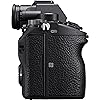Sony Alpha 7R III Mirrorless Camera with 42.4MP Full-Frame High Resolution Sensor, Camera with Front End LSI Image Processor, 4K HDR Video and 3" LCD Screen Black









Buy Now, Pay Later
- – Up to 36-month term if approved
- – No impact on credit
- – Instant approval decision
- – Secure and straightforward checkout
Ready to go? Add this product to your cart and select a plan during checkout.
Payment plans are offered through our trusted finance partners Klarna, Affirm, Afterpay, Apple Pay, and PayTomorrow. No-credit-needed leasing options through Acima may also be available at checkout.
Learn more about financing & leasing here.
Selected Option
FREE refund/replacement until Jan 31, 2026 Learn more
To qualify for a full refund, items must be returned in their original, unused condition. If an item is returned in a used, damaged, or materially different state, you may be granted a partial refund.
To initiate a return, please visit our Returns Center.
View our full returns policy here.
Set: New Version - a7R III
Features
- 42.4MP full-frame Exmor R CMOS sensor and BIONZ X processor
- Real-time AF tracking and Real-time Eye-AF for humans and animals
- Wide dynamic range, 14-bit uncompressed RAW, ISO 50 to 102,4005
- Fast Hybrid autofocus: 399 phase-detection / 425 contrast AF points
- Up to 10fps continuous shooting at 42.4MP with AE/AF tracking
Description
An entirely renewed image processing system further enhances the Sony Alpha 7R III high-resolution mirrorless camera's image quality; with up to approximately 2x improved AF speed, AF tracking, and Eye AF tracking performance, up to 10fps continuous shooting, pro-style reliability and operability packed within a strong, compact body, the Sony Alpha 7R III provides superior imaging quality, flexibility and mobility.
Compatible Mountings: Sony E
Aspect Ratio: 32
Photo Sensor Technology: CMOS
Supported File Format: JPEG, Raw
Image Stabilization: Sensor-shift
Optical Zoom: 1 x
Maximum Aperture: 4 f
Expanded ISO Minimum: 50
Metering Description: Center-Weighted Average, Highlight Weighted, Multi-Zone, Spot
Brand: Sony
Brand: Sony
Model Name: Sony Alpha 7R III
Built-In Media: Camera Body & Accessories
Are Batteries Included: Yes
Model Number: ILCE7RM3A/B
Remote Included: No
Model Series: Alpha
Series Number: 3
UPC: 027242922082
Item Height: 5.6 inches
Manufacturer: Sony
Warranty Description: 1 year limited manufacturer
Metering Methods: Center-Weighted Average, Highlight Weighted, Multi-Zone, Spot
Exposure Control: Aperture Priority, Auto, Manual, Program, Shutter Priority
White Balance Settings: Auto, Cloudy, Color Temperature, Custom, Daylight, Flash torch, Fluorescent, Incandescent, Shade, Underwater
Self Timer: 10 Seconds, 2 Seconds, 5 Seconds
Crop Mode: Full-Frame
Screen Size: 3 Inches
Display Type: LCD
Display Fixture Type: Tilting
Display Resolution Maximum: 1920 x 1080
Has Color Screen: Yes
Flash Memory Type: Slot 1 SD/SDHC/SDXC (UHS-II)Slot 2 SD/SDHC/SDXC/Memory Stick Duo Hybrid (UHS-I)
Memory Slots Available: 2
Recording Capacity: 30 Minutes
Flash Memory Speed Class: UHS-I
Flash Memory UHS Speed Class: UHS-II
Compatible Mountings: Sony E
Sensor Type: CMOS
Image stabilization: Sensor-shift
Maximum Aperture: 4 f
Expanded ISO Minimum: 50
Photo Sensor Resolution: 42.4 MP
Photo Sensor Size: Full Frame (35mm)
Maximum Shutter Speed: 30 seconds
Minimum Shutter Speed: 0.004 seconds
Form Factor: Mirrorless
Special Feature: Brightness Control
Color: Black
Item Weight: 1 Pounds
Video Resolution: 4320p
Viewfinder: Electronic
Flash Modes: TTL
Camera Flash: Hotshoe
Skill Level: Professional
Specific Uses For Product: Professional Photography
Compatible Devices: Sony E-Mount Cameras
Continuous Shooting: 10 FPS
Aperture modes: Auto/Manual
Viewfinder Magnification: 0.78x
Audio Input: Built-in microphone
Flash Sync Speed: 1/250 Second
Video Capture Format: 4k
Expanded ISO Maximum: 102400
Battery Weight: 3 Ounces
Delay between shots: 0.1 Seconds
Audio Output Type: Headphones
Aspect Ratio: 32
File Format: JPEG, Raw
Effective Still Resolution: 42.4 MP
JPEG Quality Level: Basic, Fine, Normal
Supported Image Format: JPEG, RAW
Bit Depth: 14 Bit
Total Still Resolution: 42.4 MP
Optical Zoom: 1 x
Lens Type: Wide Angle
Zoom: Digital Zoom
Minimum Focal Length: 1.25 Feet
Focal Length Description: 24-70 millimeters
Digital Zoom: 4 x
Number of Diaphragm Blades: 9
Photo Filter Thread Size: 77 Millimeters
Lens Construction: 17 Elements in 14 Groups
Photo Filter Size: 77 Millimeters
Connectivity Technology: Bluetooth, HDMI, NFC, USB, Wi-Fi
Wireless Technology: Bluetooth, Wi-Fi
Video Output: Micro-HDMI
Total USB 3.0 Ports: 1
Total USB Ports: 1
Total Video Out Ports: 1
Shooting Modes: AUTO (iAuto), Programmed AE (P), Aperture priority (A), Shutter-speed priority (S), Manual (M), Movie modes
Digital-Still: No
Movie Mode: Yes
Image Capture Type: Video
Night vision: No
Auto Focus Technology: Eye Detection
Focus Features: Hybrid
Autofocus Points: 399
Focus Type: Automatic, Continuous-Servo AF, Direct Manual Focus, Manual Focus, Single-Servo AF
Focus Mode: Continuous-Servo AF (AF-C)
Autofocus: Yes
Frequently asked questions
To initiate a return, please visit our Returns Center.
View our full returns policy here.
- Klarna Financing
- Affirm Pay in 4
- Affirm Financing
- Afterpay Financing
- PayTomorrow Financing
- Financing through Apple Pay
Learn more about financing & leasing here.
Similar Products
Top Amazon Reviews


















![Canon PowerShot Digital Camera [G7 X Mark II] with Wi-Fi & NFC, LCD Screen, and 1-inch Sensor - Black, 100-1066C001](https://m.media-amazon.com/images/I/81ap5aHOZdL._AC_US500_.jpg)




